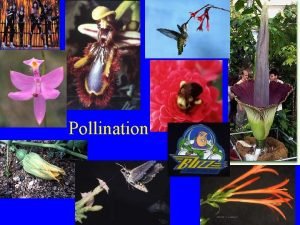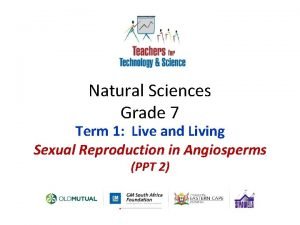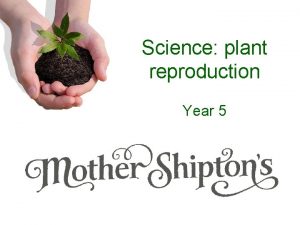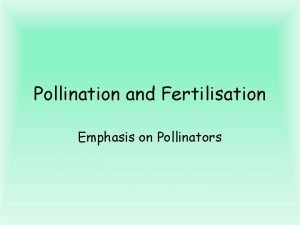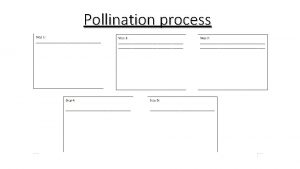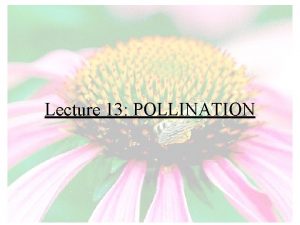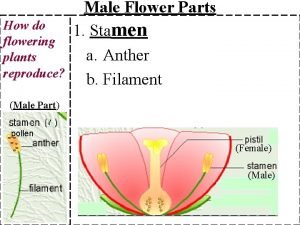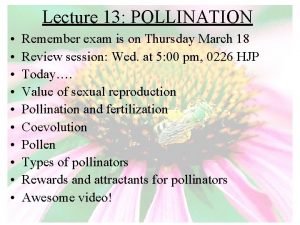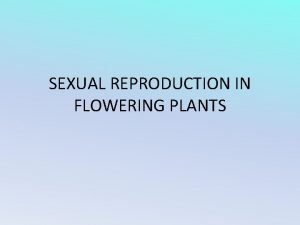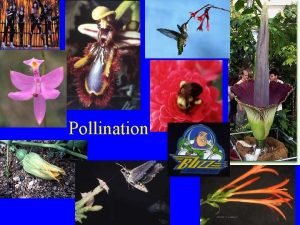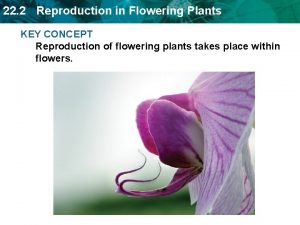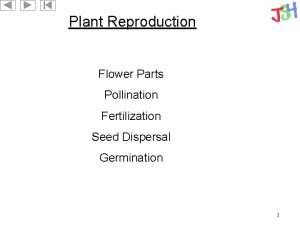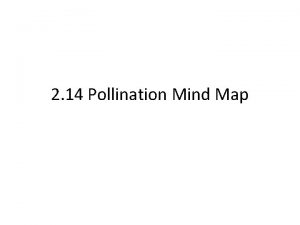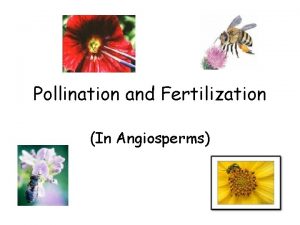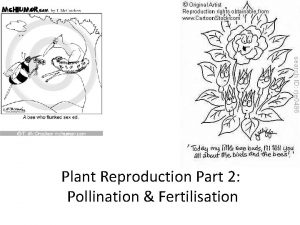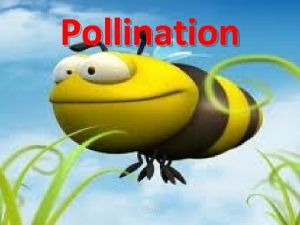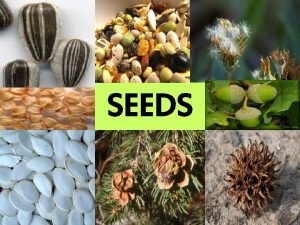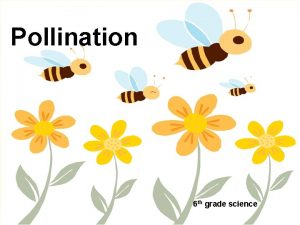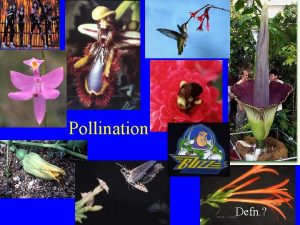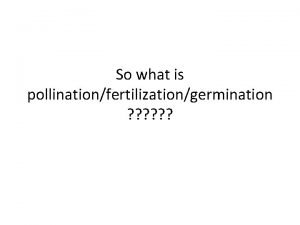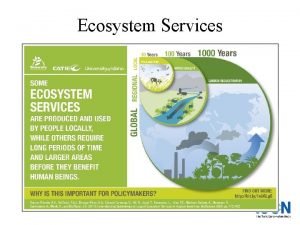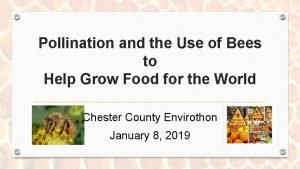Lecture 13 POLLINATION What is pollination Pollination The





















- Slides: 21

Lecture 13: POLLINATION

What is pollination? • Pollination: The transfer of pollen from the male anther to the female stigma

Why is pollination important? • Sexual reproduction is important for evolution: • Sexual reproduction produces variable offspring if two flowers are used, creating diversity and variation among populations (shuffling of genes) • Outbreeding = good! (inbreeding = bad…)

Sexual reproduction • In animals: It’s easy because you have separate male and female individuals. • In flowering plants: Not so easy, because most flowers that have both male and female parts in them, are called perfect flowers. • So flowering plants have evolved special ways to insure outbreeding/outcrossing – and to prevent inbreeding.

Pollination and Fertilization • Pollen contains TWO nuclei: a sperm nucleus and tube nucleus • Sperm nucleus is protected in gametophyte tissue (pollen can travel in the air)

Pollination and Fertilization • For pollen sperm to successfully fertilize the egg, there must be pollination: a method to get the pollen from the male anther to the stigma. • Pollen sticks to the stigma, starts growing a pollen tube • Fertilization begins when tube begins to grow toward the egg

• https: //www. youtube. com/watch? v=26 oq 5 t Wrb 2 Q

How do plants get pollen from one plant to another? • Wind • Animals • Water

How do plants get pollen from one plant to another? • Because plants are rooted in the ground, they must use different strategies: • WIND POLLINATION: • Gymnosperms and some flowering plants (grasses, trees) use wind pollination. • Flowers are small, grouped together • Not a very efficient method (too chancy and wasteful)

ANIMALS • Many flowering plants rely on animals for crosspollination: • Insects – bees, wasps, flies, butterflies, moths • Birds – hummingbirds, honey creepers • Mammals – bats, mice, monkeys • Even some reptiles and amphibians!

Coevolution • Coevolution – interactions between two different species as selective forces on each other, resulting in adaptations that increase their interdependency. • Animal-flowering plant interaction is a classic example of coevolution: • 1. Ex. - Plants evolve methods to attract animal pollinators • 2. Animals evolved specialized body parts and behaviors that aid plant pollination

3 ways plants attract pollinators • Colors – bees see blue, yellow UV; while birds see red Bats don’t see well, so flowers are white. • Aromas – for insects, nectar. Can also be carrion or dung smell • Nectar or pollen– a visual guide for pollinator to locate the reward (pansy flower)

Why do animals pollinate plants? • They get a REWARD: food! In exchange for moving their pollen to another flower • Nectar – a sugary solution produced in special flower glands called nectaries • Nectar concentration matches energy requirements of the pollinator: bird- and bee-pollinated flowers have different sugar conc. • Pollen – is high in protein, some bees and beetles eat it. • Flowers can produce two kinds of pollen: a normal and a sterile, but tasty, kind, for the insect.

Animal pollinators: Bees • Bees – are the most important group of flower pollinators • They live on the nectar and feed larvae, also eat the pollen. • Bees are guided by sight and smell • See yellow and blue colors, also ultraviolet light (not red) • Flowers have “honey guides” and bee landing platforms. .

Butterflies and moths • Also guided by sight and smell • Butterflies can see red and orange flowers • Usually shaped as a long tube because of insect’s proboscis – to get nectar • Moth-pollinated flowers are usually white or pale, with sweet, strong odor – for night pollination.

Flies and beetles • Flies like flowers that smell like dung or rotten meat. • Lay their eggs there, but larvae die due to lack of food • Beetles pollinate flowers that are dull in color, but have very strong odor

Birds • Birds have a good sense of color, they like yellow or red flowers… • But birds do not have a good sense of smell, so bird-pollinated flowers usually have little odor. • Flowers provide fluid nectar in greater quantities than insects • Hummingbird-pollinated flowers usually have long, tubular corolla • Pollen is large and sticky

Mammals: bats and mice • Bats pollinate at night, so flowers are white • Mouse-pollinated flowers are usually inconspicuous, they open at night

Plant Mimicry • Some plants take advantage of the sex drive of certain insects… • Certain orchids look like female wasps, and even smell like them! • Males try to mate with them, and in the process they pollinate the plant • The orchid gets pollinated, but the male wasp only gets frustrated!

A word about pollen… • The shape and form of pollen is related to its method of pollination… • Insect-pollinated species have sticky or barbed pollen grains • Wind-pollinated species is lightweight, small and smooth

 01:640:244 lecture notes - lecture 15: plat, idah, farad
01:640:244 lecture notes - lecture 15: plat, idah, farad Regular vs irregular flowers
Regular vs irregular flowers Pollination syndrome
Pollination syndrome Trophic cascade
Trophic cascade Natural science grade 7
Natural science grade 7 Pollination fertilisation seed dispersal germination
Pollination fertilisation seed dispersal germination Pollination experiment
Pollination experiment Self pollination
Self pollination Pollination process
Pollination process Pollination meaning
Pollination meaning Purpose of pollination
Purpose of pollination Pollination
Pollination Male parts of a flower
Male parts of a flower Pollination
Pollination Longitudinal groove in anther
Longitudinal groove in anther Pollination syndrome
Pollination syndrome Pollination occurs when a pollen grain
Pollination occurs when a pollen grain Germinating seed
Germinating seed Pollination mind map
Pollination mind map Sự nuôi và dạy con của hươu
Sự nuôi và dạy con của hươu Thế nào là mạng điện lắp đặt kiểu nổi
Thế nào là mạng điện lắp đặt kiểu nổi Hát kết hợp bộ gõ cơ thể
Hát kết hợp bộ gõ cơ thể


